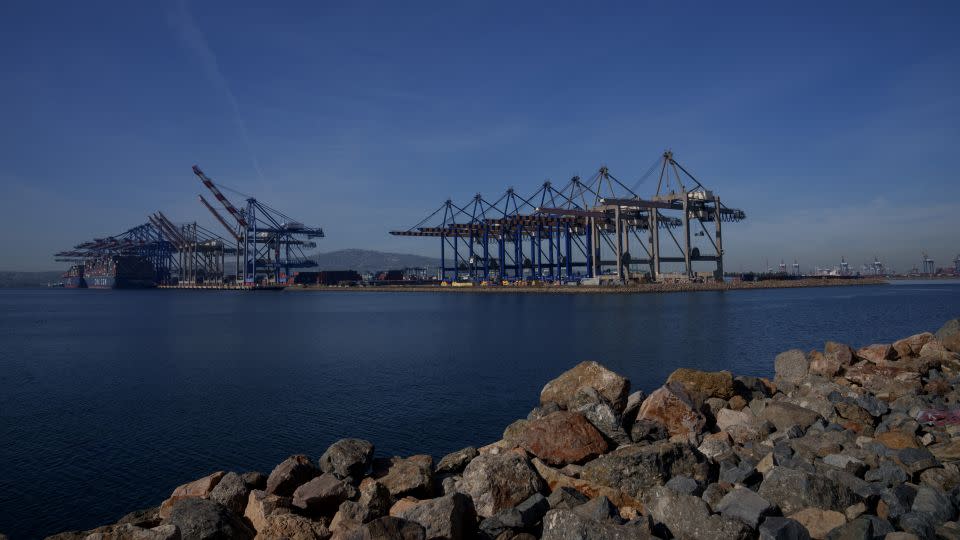How the Red Sea crisis could clobber the global economy
Attacks by Iran-backed militants in the Red Sea have effectively closed one of the world’s main trade routes to most container ships — vessels that carry everything from car parts to Crocs from one corner of the globe to another.
A prolonged closure of the waterway, which connects with the Suez Canal, could snarl global supply chains and drive up the prices of manufactured goods at a crucial moment in the battle to defeat inflation. The Suez Canal accounts for 10-15% of world trade, which includes oil exports, and for 30% of global container shipping volumes.
The Houthi militants, based in Yemen, say they are taking revenge for Israel’s war against Hamas in Gaza. The US military and its allies have beefed up maritime security but the attacks continue — 21 Houthi missiles and drones were shot down late Tuesday.
As the crisis persists, the stakes for the global economy are rising.
Global trade fell 1.3% from November to December, Germany’s Kiel Institute for the World Economy said Thursday, citing “consequences of the attacks on cargo ships in the Red Sea.”
Retailers are warning of shipment delays, and the cost of moving goods by sea is increasing.
In a biannual report released Tuesday, the World Bank warned that the disruption to key shipping routes was “eroding slack in supply networks and increasing the likelihood of inflationary bottlenecks.”
Six of the 10 biggest container shipping companies — namely Maersk, MSC, Hapag-Lloyd, CMA CGM, ZIM and ONE — are largely or completely avoiding the Red Sea because of the threat from the Houthi militants.
The danger to crew, cargo and vessels has forced carriers to reroute ships around the Cape of Good Hope in South Africa, resulting in delays of up to three weeks. Maersk CEO Vincent Clerc told the Financial Times Thursday that re-establishing safe passage through the Red Sea could take “months.” “It could potentially have quite significant consequences on global (economic) growth,” he added.
Already, shipping costs have surged, which could ultimately show up in consumer prices. “The longer the disruptions persist, the stronger the stagflationary effects for the global economy,” chief economist at Allianz, Mohamed A. El Erian, wrote last week on X, referring to a toxic combination of low or zero economic growth and high inflation.
If the Israel-Hamas war escalates into a wider regional conflict or the Houthis decide to redirect their attacks toward oil tankers and bulk carriers — which transport crucial raw materials such as iron ore, grain and timber — the consequences for the global economy would be altogether more severe.
“In a setting of escalating conflicts, energy supplies could also be substantially disrupted, leading to a spike in energy prices,” the World Bank report added. “This would have significant spillovers to other commodity prices.”
The threat to energy prices is the biggest risk, according to Capital Economics.
“While current shipping disruptions themselves are unlikely to disrupt the global trend of falling inflation, a marked escalation of the underlying military conflict could boost energy prices, which would be passed onto consumers,” Simon MacAdam and Lily Millard, economists at the consultancy, wrote in a note last week.
Oxford Economics also expects that inflation will continue easing but still sees an upside risk to prices. If container transport costs stay around their current levels — almost twice the level of early December — this might boost world inflation by about 0.6 percentage points, Ben May, director of global macroeconomic research at the firm, wrote in a note on January 4.
Delivery delays
Some European automakers have rerouted their shipments around the Cape of Good Hope. “This has entailed higher costs and delays of around two weeks,” said a spokesperson for the European Automobile Manufacturers’ Association.
And retailers such as Swedish furniture company Ikea have warned of shipment delays and possible shortages of certain products. Similarly, British clothing retailer Next said last week: “Difficulties with access to the Suez Canal, if they continue, are likely to cause some delays to stock deliveries in the early part of the year.”
Crocs (CROX) has likewise said items destined for Europe are taking two weeks longer than usual to arrive. The shoemaker does not expect a “material impact” on its business for now but told CNN it would “continue to monitor the situation closely.”
It’s not alone. Businesses around the world are on tenterhooks, hoping the disruption will end soon but beginning to dust off contingency plans last deployed during the pandemic if it doesn’t.
Abercrombie & Fitch (ANF) plans to use air freight wherever possible to avoid delays, according to an email to suppliers seen by Bloomberg. “We shift transportation modes and/or shipping lanes when warranted to maintain flow of goods,” a company spokesperson told CNN.

The situation could worsen in the coming weeks as shippers rush to get orders out of China before factories close for the country’s Lunar New Year holiday.
“The next five weeks leading to Chinese New Year on the 10th of February are going to be very difficult for shippers and for shipping,” Philip Damas, head of Drewry Supply Chain Advisors, said in recorded comments posted online Monday.
He noted, however, that excess shipping capacity more broadly meant spot rates — the price of one-off freight shipments as opposed to prices agreed in advance — “will decline again after Chinese New Year.”
‘Total crunch’
In addition to a surge in spot freight rates from the Red Sea attacks, carriers are tacking on emergency surcharges.
“All-in prices” of $5,000-$8,000 per container for major trade routes originating in Asia are 2.5 to 4 times the “normal levels” for this time of year, according to estimates by Judah Levine, head of research at logistics firm Freightos.
However, that is still 45%-75% below their “pandemic peak” in late 2021, Levine noted. Back then, soaring demand for goods from housebound consumers collided with supply bottlenecks, ranging from container shortages to port congestion.

The Suez Canal debacle adds to existing problems in shipping, with traffic through the vital Panama Canal already restricted because of a severe drought.
“For companies trying to move goods across the world you have a total crunch right now — you can’t rely on the Panama Canal (and) you can’t rely on the Suez Canal,” said Carolina Klint, chief commercial officer for Europe at Marsh McLennan, a professional services firm.
Some ocean carriers that ordinarily transit through the Panama Canal had rerouted to the Suez Canal before the attacks in the Red Sea escalated, according to logistics company C.H. Robinson.
Matthew Burgess, vice-president of global ocean services at the firm, said global shipping capacity would be constrained for a while yet. “There will be a shortage of Asia-to-Europe space for, at a minimum, the next eight weeks due to the additional time needed to use the Cape of Good Hope routing,” he told CNN.
“As we’ve seen with previous global shipping disruptions, shortages of empty equipment will likely be a fast follow, which further elevates delays because companies may need to wait two-three additional weeks for an empty container.”
At least for now, major ports in Europe and the United States — including the Port of Rotterdam, the Port of Los Angeles and the Port of New York and New Jersey — have seen limited impact from the Red Sea crisis. But they are on high alert for potential fallout.
“It is yet another disruption in the supply chain,” Gene Seroka, executive director of the Port of Los Angeles, told CNN. “This is not going away in three or four weeks.”
And even if the attacks stopped today, allowing most vessels to transit the Red Sea, the earlier impacts could still reverberate for some time to come, according to Burgess of C.H. Robinson. “The disruption and delays already in play will take a significant amount of time to resolve.”
For more CNN news and newsletters create an account at CNN.com
